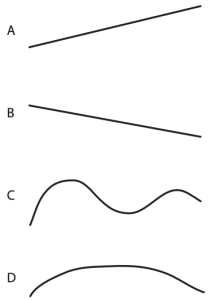5. Melody
The melody of a song is often its most distinctive characteristic. The ancient Greeks believed that melody spoke directly to the emotions. Melody is the part of the song that we hum or whistle, the tune that might get stuck in our heads. A more scientific definition of melody might go as follows: melody is the coherent succession of definite pitches in time. Any given melody has range, register, motion, shape, phrases, as well as rhythmic organization.
The first of these characteristics, range, is one that we’ve already encountered as we talked about pitch. The range of a melody is the distance between its lowest and highest notes. We talk about melodies having narrow or wide ranges. Register is also a concept we discussed in relation to pitch. Melodies can be played at a variety of registers: low, medium, high.
As melodies progress, they move through their given succession of pitches. Each pitch is a certain distance from the previous one and the next. Melodies that are meant to be sung tend to move by small intervals, especially by intervals of seconds (steps). A tune that moves predominantly by step is a stepwise melody. Other melodies have many larger intervals that we might describe as “skips” or “leaps.” When these leaps are particularly wide and with rapid changes in direction (that is, the melody ascends and then descends and then ascends and so forth), we say that the melody is disjunct. Conversely, a melody that moves mostly by step, in a smoother manner—perhaps gradually ascending and then gradually descending—might be called conjunct.
Shape is a visual metaphor that we apply to melodies. Think of a tune that you know and like: it might be a pop tune, it might be from a musical, or it might be a song you recall from childhood. Does it correspond with any of the shapes in Figure 1.10? In other words, do the pitches of the melody primarily ascend (shape A)? Descend (shape B)? Oscillate, much like a wave (shape C)? Ascend, arch up, and then descend (shape D)? These are shapes that we might hear unfolding over time.

As we think back to a melody that we know, we can replay it in our mind and visualize the path that it traces. Sing the childhood tune “Row, Row, Row Your Boat” to yourself. Which shape from Figure 1.10 do you think it is most like? “D” is the best answer. Now look at the musical notation for “Row, Row, Row Your Boat.”

Even if you can’t read music, hopefully you can see how the note heads trace an arch-like shape, similar to the shape labeled “D” in Figure 1.10. Most melodies have smaller sub-sections called phrases. These phrases function somewhat like phrases in a sentence. They are complete thoughts, although generally lacking a sense of conclusion. In the song “Row, Row, Row Your Boat,” the music corresponding with the words “Row, row, row your boat,” might be heard as the first phrase and “gently down the stream,” as the second phrase. “Merrily, merrily, merrily, merrily,” completes the third phrase, and “life is but a dream,” the fourth and final phrase.
Melodies are also composed of motives. A motive is the smallest musical unit, generally a single rhythm of two or three pitches. In “Row, Row, Row Your Boat,” the music set to “merrily” might be heard as a motive. Motives repeat, often in sequence. A sequence is a repetition of a motive or phrase at a different pitch level. Thus, in “Row, Row, Row Your Boat,” the first time you hear “merrily” is when it is at the top of the melody’s range. The next time, it is a bit lower in pitch, the next time a bit lower still, and the final time you hear the word, it is sung to the lowest pitch of the melody.
Another song that you might know that has sequences is “My Country, ’Tis of Thee.” (First time at 0:14, “Land where my fathers died. Land of the Pilgrims’ pride!” from the first verse)
Ex. 1.12: “My Country, ’Tis of Thee” performed by the Tabernacle Choir and Orchestra
A succession of single tones in musical compositions.
A melody with wide leaps and rapid changes in direction.
A melody that moves mostly by step, in a smooth manner.
Smaller sub-sections of a melody.
The smallest musical unit of a melody, generally a single rhythm of two or three pitches.
A repetition of a motive or phrase at a different pitch level.
